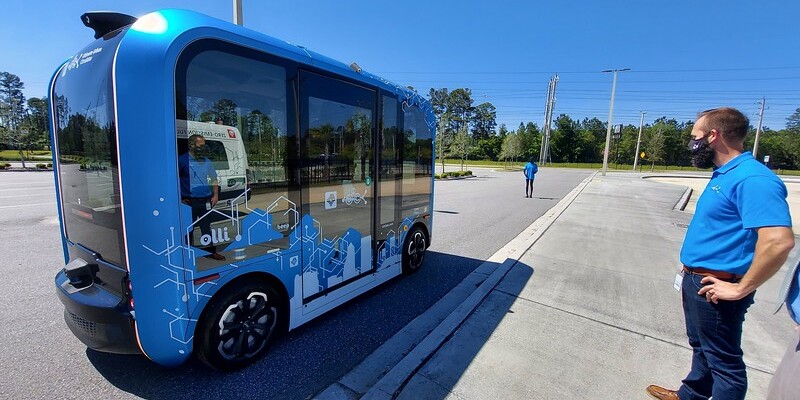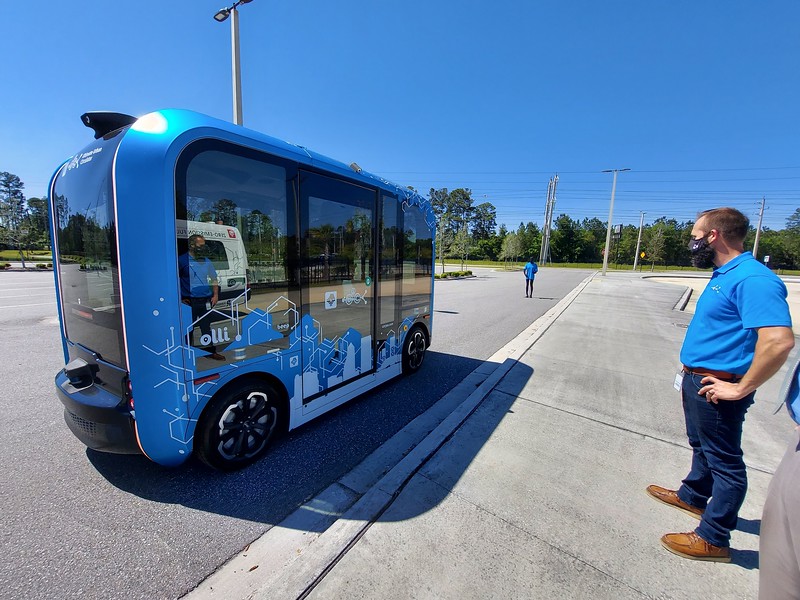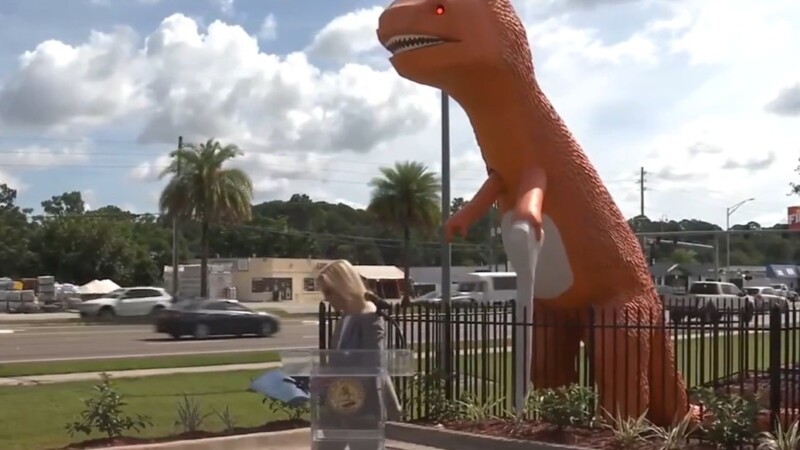
Six years after the Jacksonville Transportation Authority announced its proposal to replace the Skyway monorail with a fleet of driverless vehicles, reports are showing the required technology is still years if not decades away. It’s time for Jacksonville leaders to cut bait on JTA’s expensive fantasy and focus on proven forms of transit.
The background

The Jacksonville Skyway, the city’s only fixed public transportation system, has glided above Downtown’s streets since 1989. The system has long been something of an albatross for city leaders, as the monorail technology it uses never caught on, planned expansions never happened and accordingly, ridership failed to meet expectations. By 2014, it was clear something had to be done with the aging Skyway, and the Jacksonville Transportation Authority (JTA) initiated a study to assess its future. As a result, on December 10, 2015, the JTA Board approved a resolution supporting the modernization and continued operation of the system.
In April 2017, JTA announced it would swing for the fences and replace the old monorail technology with a new, futuristic system of autonomous shuttles it called the Ultimate Urban Circulator, or for some reason, the “U2C.” Significant portions of the stated plan have remained unclear, but effectively, the project would replace the Skyway trains with driverless shuttles that would not only ride around the existing elevated structures but also extend out on city streets to other neighborhoods. JTA claimed at the time that driverless technology was right around the corner, and the plan would put Jacksonville at the forefront of a revolutionary advancement in public transit.
The plan drew skepticism from the start. Back in 2018, we argued that the vehicles JTA was testing were too small and slow to make for effective public transit. The system also lacked dedicated right-of-way on some streets, meaning these small, slow shuttles would mix in traffic with cars and kill any possibility of meeting a regular schedule. The plans also left out Urban Core neighborhoods, where many residents already use public transit, solidifying the impression that the U2C was intended more as a diversion for office workers and urban bobos rather than a real transit system. Others, including the Urban Land Institute and Chris Hand, the city of Jacksonville’s chief of staff from 2011-2015, have expressed similar concerns.
We’ve repeated similar critiques many times since, but JTA has remained firm in its belief that autonomous vehicles are the future of transit. Unfortunately, the industry that’s been working on building these vehicles has come to a different conclusion: The technology just isn’t ready, and won’t be for a long time.
A risky bet on unproven technology

There was always a risk that JTA’s bet on its ability to pioneer a totally new transit technology wouldn’t pay off. In fact, this has already happened, as several transit providers in Florida alone have beaten JTA to the punch by launching autonomous shuttle systems. Those that exist are uniformly lackluster in their ability to serve as reliable mass transit solutions, showing how far JTA still has to go to launch its U2C.
A Bloomberg story from October 2022 shows why: Companies like Google, GM, Ford and Tesla have spent $100 billion developing driverless technology to date, only to conclude that it’s still very far from primetime. Despite some notable advancements, driverless vehicles still struggle with rain, construction, unexpected pedestrians and animals — and even simple left turns. Even driverless taxis are rare, and those that exist are notorious for squirrelly behavior. The Bloomberg piece starts with a story about a stream of Google SUVs repeatedly getting confused by a dead end and doing K-turns in the driveway of one perplexed San Franciscan.
JTA has experienced these hurdles firsthand. In 2020, the Olli 2.0 became the latest autonomous vehicle to join JTA’s Test & Learn Program. “The delivery of the Olli 2.0 at our Test & Learn track marks the next step in shaping the future of public transportation– not just in Jacksonville, but nationally,” JTA Chief Executive Officer Nathaniel P. Ford Sr. said at the time. However, Local Motors, the company behind the vehicles, shut down for good in January 2022 due to a lack of funding. So much for shaping the future of public transportation.
The Olli shuttle had never been intended as a mass transit solution; it was designed for environments like hospitals, military bases and universities. The episode shows that Jacksonville faces another risk beyond driverless technology’s uncertain future. Our primary challenge is that JTA hopes to force the existing technology to play a public transportation role that it was never intended for.
A representative of mobility-as-service provider Beep, in a recent pilot project article, said that in order to function safely and successfully in the real world, autonomous shuttles require a very controlled setting. The article goes on:
“Indeed, in calling them ‘shuttles,’ this also defines their primary market — low volume and last-mile transit. That typically means fixed route and sometimes fixed schedule service. To overcome the hard problems, many shuttles have operated only on private campuses or very limited routes. Last mile shuttles will run from a train station for a mile or so to bring people to and from the train.”
What’s described is known in transit-speak as a first-last-mile micromobility option. The first and last mile here represents the distance you cover between the transit stop and your final destination. Electric scooters, bike rentals and dockless bicycles are existing examples of this. In this context there may be space for autonomous shuttles in the local environment. However, they aren’t intended to be a replacement for higher-capacity fixed public transit systems like the Skyway or more prevalent systems like Light Rail Transit or streetcars.
In fact, none of the vehicles JTA is testing can carry as many people or move as quickly as light rail, streetcars, or buses – or even the existing, increasingly deteriorated Skyway cars. Even in the best case scenario, the U2C will carry only a fraction of people as the aging system it’s intended to replace.
Costs and benefits

This brings up yet another issue with the Skyway replacement plan: its exorbitant cost. The system is expected to cost $450 million, more than twice as much as the $180 million Skyway. What’s more is that the stated costs continue to spike, and given the hazy future of the technology involved, further increases can be expected.
The cost of the project has been a thorny issue for years. In 2021, City Council members balked when JTA requested $379 million in funding for the Skyway overhaul as part of a gas tax increase proposed by Mayor Lenny Curry to fund infrastructure. This ask would have accounted for nearly 40% of the tax’s total revenues, which nearly sank the entire proposal when City Council debated it. The gas tax ultimately moved forward when Council Member Matt Carlucci proposed a compromise: $150 million would be stripped from the Skyway project and put toward park and roadway infrastructure connected to the Emerald Trail project.
This was the right move. It not only saved a proposal for badly needed infrastructure funding, it freed up more dollars for projects that will benefit residents and their neighborhoods in the next few years.
Now, more than two years later, and more than five years after JTA first pitched its Skyway replacement plan, it’s time to do some serious soul searching. The U2C still isn’t anywhere close to happening, nor is the project getting any cheaper. There are other options for public transit — light rail, streetcars, buses — that are cheaper, carry more passengers and are available to plan and implement right now.
Jacksonville has now spent nine years looking at the Skyway and planning this replacement without clear progress to show for it. It’s time to cut bait and work to meet Jacksonville’s needs by putting the resources into proven forms of transit.








